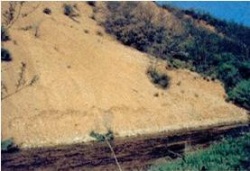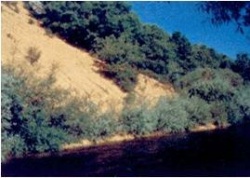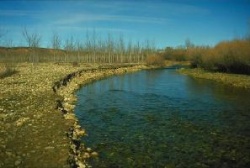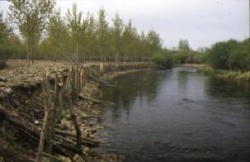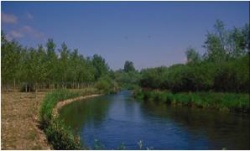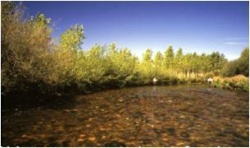Difference between revisions of "Carrión"
From REFORM wiki
m (→Measures selection) |
m (→Socio-economic aspects) |
||
| (11 intermediate revisions by the same user not shown) | |||
| Line 23: | Line 23: | ||
==Success criteria== | ==Success criteria== | ||
| + | :* In terms of cost-effectiveness we can say that the degree of success was high. The objectives were achieved. | ||
==Ecological response== | ==Ecological response== | ||
| + | :* At the first moment the presence of boulders involved a negative visual impact. however, the monitoring done by the Junta de Castilla y León through electrofishing proved the effectiveness of this action near some spawning areas. | ||
| + | :* Trout population density was increased. | ||
==Hydromorphological response== | ==Hydromorphological response== | ||
| + | :* After three years, the plants from the live fences had rooted successfully, withstanding the river overflows. | ||
| + | :* Single stakes were carried during the floods of February 1996.<br /> | ||
| + | :* One year after restoration,the percentage of dead stakes of the buffer strip was lower than 3 %. It resisted overflows that surpassed the structure and flooded the poplar.<br /> | ||
| + | [[Image:Carrión1.jpg|left|thumb|250px|Margins of Carrión river in 1994, before the restoration. Image: Schmidt and Otaola, 2002]] | ||
| + | [[Image:Carrión2.jpg|center|thumb|250px|Margins of Carrión river in 1997. Image: Schmidt and Otaola, 2002]] | ||
| + | [[Image:Carrión3.jpg|left|thumb|250px|Revegetation of the shore. In 1997, before the project. Image: Schmidt and Otaola, 2002]] | ||
| + | [[Image:Carrión4.jpg|center|thumb|250px|Revegetation of the shore. In 1997, during the actions. Image: Schmidt and Otaola, 2002]] | ||
| + | [[Image:Carrión5.jpg|left|thumb|250px|Situation in 1998, after the actions.Image: Schmidt and Otaola, 2002]] | ||
| + | [[Image:Carrión6.jpg|center|thumb|250px|Situation in 1999, after the actions.Image: Schmidt and Otaola, 2002]]<br /><br /><br /> | ||
==Monitoring before and after implementation of the project== | ==Monitoring before and after implementation of the project== | ||
| + | :* The effectiveness of the project was monitored by the Junta de castilla y León almost untill 1999. The evolution of trout population was measured with periodic samplings (electrofishing). | ||
==Socio-economic aspects== | ==Socio-economic aspects== | ||
| + | :* There is not a precise data about the costs, but they were low. Machinery was only requested for placing the boulders. The rest of the works were done by volunteers (AEMS, Ríos con Vida) and the fluvial nursery. | ||
==Contact person within the organization== | ==Contact person within the organization== | ||
| Line 39: | Line 53: | ||
==References== | ==References== | ||
<references/> | <references/> | ||
| + | :Schmidt, G. & M. Otaola-Urrutxi (2002): La aplicación de técnicas de bioingeniería en la restauración de ríos y riberas. Ministerio de Fomento. CEDEX. Monografías M70, ISSN: 0211-8203. ISBN: 84-7790-374-3, 163-02-005-0. Madrid<br /> | ||
| + | :http://riosconvida.es/<br /> | ||
| + | |||
[[Category:Case_studies]] | [[Category:Case_studies]] | ||
Latest revision as of 17:05, 20 May 2010
Carrión
Key features of the case study
Attention: the source of the following text is "Estudio de técnicas de restauración ecológica aplicada a los principales habitat(MARM, 2010).
The Carrión river restoration located in Fresno del Río and Pino del Río (Palencia) covered a river reach with maximum flows between 218 and 527 m3/s, which is regulated by Camporredondo and Compuerto dams. The minimum flows is about 2 m3/s, set by the Confederación Hidrográfica del Duero. The concern about this reach was due to shore erosion and the lack of refuge for trout.
Site description
Measures selection
In order to mitigate the impact of flow regulation and to improve the aquatic habitat for fish, several actions took place both instream and at the riparian zone:
- Boulders (limestone) were placed in the riverbed for improve the instream structure and habitat diversity. The diameter of the boulders ranged between 60 - 80 cm.
- Revegetation of the margins with four live fences: 200 stakes of willows from the proximities of the site and four stakes of aspen (Populus tremula). Aspen stakes were around 2 m long and with a diameter of 2 cm (two years). They were embedded vertically into the soil with a slight inclination towards the slope, very close, filling the trench with the extracted material and compacting over the stakes.
- Revegetation with single stakes. Because of lack of time, they were left along the banks hardly embedded, just covered with slope material. They didn´t develop an important root system as they were near to the water table.
- Plantation of 170 stakes (75 % Salix fragilis and 25% of Salix purpurea and Salix atrocinerea), with the aim of protecting a plantation of poplars (adjust land use to prevent shore erosion )
- Construction of a wing deflector consisting of stones, logs, and branch cuttings of willow and aquatic plants for its stabilization.
- Plantation of branch cuttings and stakes of willow at stable margins to give shading and shelter for the trouts.
Success criteria
- In terms of cost-effectiveness we can say that the degree of success was high. The objectives were achieved.
Ecological response
- At the first moment the presence of boulders involved a negative visual impact. however, the monitoring done by the Junta de Castilla y León through electrofishing proved the effectiveness of this action near some spawning areas.
- Trout population density was increased.
Hydromorphological response
- After three years, the plants from the live fences had rooted successfully, withstanding the river overflows.
- Single stakes were carried during the floods of February 1996.
- One year after restoration,the percentage of dead stakes of the buffer strip was lower than 3 %. It resisted overflows that surpassed the structure and flooded the poplar.
Monitoring before and after implementation of the project
- The effectiveness of the project was monitored by the Junta de castilla y León almost untill 1999. The evolution of trout population was measured with periodic samplings (electrofishing).
Socio-economic aspects
- There is not a precise data about the costs, but they were low. Machinery was only requested for placing the boulders. The rest of the works were done by volunteers (AEMS, Ríos con Vida) and the fluvial nursery.
Contact person within the organization
Extra background information
References
- Schmidt, G. & M. Otaola-Urrutxi (2002): La aplicación de técnicas de bioingeniería en la restauración de ríos y riberas. Ministerio de Fomento. CEDEX. Monografías M70, ISSN: 0211-8203. ISBN: 84-7790-374-3, 163-02-005-0. Madrid
- http://riosconvida.es/
Related Measures
- Initiate natural channel dynamics to promote natural regeneration
- Add sediments
- Adjust land use to reduce nutrient, sediment input or shore erosion
- Revegetate riparian zones
